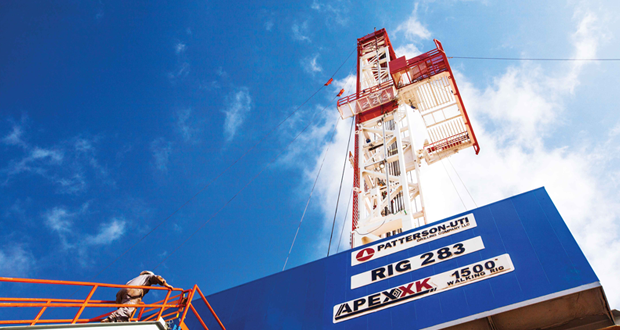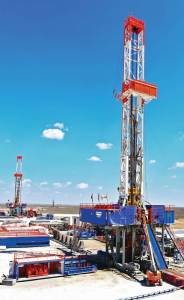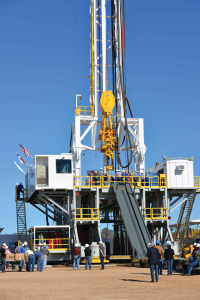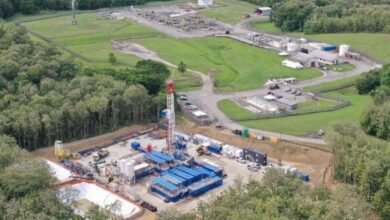US shale production expected to rise even as rig count tumbles

Operators, contractors focus on high-grading crews and rigs, drilling optimization to lower costs and prepare for the next upturn
By Kelli Ainsworth, Editorial Coordinator
 Last year, the US land rig count peaked in November at 1,859. As of 10 April, that number had tumbled to 951, according to the Baker Hughes Rig Count. It’s a glaring indicator of the weak rig market. Yet, unlike earlier years, it is no longer an indicator of oil and gas production. In fact, production from US shales is expected to rise in 2015 despite the steep decline in rig count.
Last year, the US land rig count peaked in November at 1,859. As of 10 April, that number had tumbled to 951, according to the Baker Hughes Rig Count. It’s a glaring indicator of the weak rig market. Yet, unlike earlier years, it is no longer an indicator of oil and gas production. In fact, production from US shales is expected to rise in 2015 despite the steep decline in rig count.
“Rig declines are not proportionate to production,” Eric Kuhle, Principle Analyst, North America Upstream at Wood Mackenzie, said. “There are several areas where the rig count reductions are basically being partially offset by faster drilling times.” For example, companies are still announcing 5-10% decreases in drilling time in the Eagle Ford, he said, while the Permian is seeing up to 20% reductions in drilling time.
In January 2015, natural gas production from US shales was at 36 billion cu ft/day. Mr Kuhle said that number is expected to reach 38 billion cu ft/day by January 2016. At the same time, Wood Mackenzie anticipates that tight oil production, which grew by 1.2 billion bbl/day in 2014, will increase by an additional 673,000 bbl/day this year and by 425,000 bbl/day in 2016.
Increased production from six major shale plays alone – Eagle Ford, Permian, Niobrara, Bakken, Haynesville and Marcellus – accounts for nearly 90% of the growth in US oil and gas production since 2012, according to the US Energy Information Administration (EIA). In 2012, the United States produced 6.5 million bbl/day of crude oil, which increased to 8.7 million bbl/day in 2014. The Bakken and Eagle Ford plays together account for 67% of oil production growth, while the Marcellus alone accounts for 75% of growth in natural gas production.

Simultaneous to this production growth is the industry’s focus on reducing costs, and one strategy that many operators are turning to is to focus on core plays, rather than growing their profile in plays they know little about. “We’re seeing a pretty broad retrenchment to core-focused activities,” Mr Kuhle said. “Companies are looking to drill their best acreage that has the lowest breakeven costs that would still be economic in the current commodity price environment.”
This type of retreat to core areas is widespread and is responsible for significant rig count declines in plays that are in the earlier stages of development, such as the Tuscaloosa Marine shale. “Because there’s a lack of infrastructure and a lack of operational knowledge and best practices for how to drill and complete those areas, they suffer more in this type of commodity price environment,” Mr Kuhle said. Currently, it costs operators approximately $10 million per well to drill in the Tuscaloosa Marine shale, compared with average well costs that run between $4.5 million and $7.5 million in the Eagle Ford, he added.
However, even within the same basin, different sub-plays can have varying breakeven costs – one of the most significant factors in an operator’s decisions about how many rigs to operate there. The Bakken, for example, is generally experiencing sharp declines in rig activity, yet sub-plays in McKenzie County, which tend to have lower breakevens because they tend to be the most productive in the Bakken, are faring better than other sub-plays in the same area, according to Wood Mackenzie.
Other areas that are expected to see increased investment during the downturn are the Cana Woodford, SCOOP (South Central Oklahoma Oil Province) and STACK plays around Oklahoma, also due to the area’s low breakevens. For example, the Springer Shale in the SCOOP has a breakeven of $41 WTI. This is comparable to the more economic plays in the Bakken, such as the Parshall/Sanish play, which has a $45 WTI breakeven, and the Karnes Trough in the Eagle Ford, with a breakeven of $48 WTI. Wood Mackenzie expects overall capital expenditure in the Cana Woodford, SCOOP and STACK plays to surpass $4 billion this year, which represents a 20-30% increase over 2014 CAPEX. Production from these three plays is expected to reach 1 million BOED by 2020, compared with a projected production of 40,000 BOED this year.
On the gas side, Mr Kuhle said he expects companies to devote a larger percentage of their total investment to the Marcellus and the Utica in 2015.
Upgrading while downsizing

For US onshore drilling contractors, workforce reductions have been widespread as rigs roll off contracts and get stacked. “I don’t know of anyone that’s putting down rigs and keeping crews. You just can’t afford to,” Mike Holcomb, President of Patterson-UTI Drilling Co, said. However, a silver lining is the opportunity for contractors to high-grade both their rigs and their people. “We really have a huge opportunity right now to put the best rig and best crews on every project. I think it will allow us to continue to drive efficiencies and have a new benchmark to compare against when we get out of this downturn,” he said.
In terms of rigs, Mr Holcomb continued, operators continue to show a preference for modern rigs with bi-fuel capabilities and walking systems that will minimize their costs and drilling times. “When given the choice, they’re going to take a high-spec rig, and they’re willing to pay more for it because it will be more efficient,” he said.
For the month of March 2015, Patterson-UTI had approximately 142 rigs working in the United States, down from a peak of 211 in October of last year. Main operational areas are the Marcellus, Eagle Ford, Mid-Continent, Haynesville, Bakken and the Rockies.
So far, Patterson-UTI’s rig count in the Marcellus has been the most stable, Mr Holcomb said, adding that gas plays are holding up better than oil plays in general. Although the Haynesville has been one of the more modest natural gas producers in recent years, especially compared with giants like the Marcellus, the rig count there has also been more stable than in oil/liquids-rich plays.
In a competitive rig market, operators’ preference for full-featured rigs with advanced technologies is being underlined. The majority of the rig count reduction since late 2014 has come from older rigs, SCANDRILL President Paul M. Mosvold said. Even when commodity prices rebound, he added, legacy rigs that lack advanced capabilities and that are too expensive to upgrade will likely be scrapped or cannibalized. “Focusing on our core values and building upon our safety and learning culture still remains the primary focus as we struggle through this challenging time in our industry,” he said.
One cost-increasing influence may be amendments to the Texas Railroad Commission’s Rule 13, which took effect 1 January 2014. The rules set stricter standards for BOP equipment that will require many older rigs to be upgraded in order to continue working.
To address Rule 13, IADC onshore leadership met with the Texas Railroad Commission in December 2014 and again in February 2015 to express concerns and seek clarifications. Drilling contractors are concerned that the rule, which is based on offshore BOP regulations, is not entirely applicable to onshore operations and may create an economic burden without delivering added safety or environmental benefits.
The Railroad Commission has agreed to review IADC’s concerns. As of early April, the association and the commission remain in continued communication to seek a mutually beneficial outcome.
On top of concerns such as Rule 13, market conditions are also placing pressure on contractors to retroactively outfit their existing rigs with walking systems and higher-pressure mud pumps, Mr Mosvold said. For some older rigs, “the cost of upgrading the rig is greater than the value of the rig.”
High-spec rigs that do continue to work share certain common features – a key one being walking systems. “Pad drilling has really developed over the past several years,” Mr Holcomb said. Out of 20 high-spec APEX rigs that Patterson-UTI built last year, 19 were equipped with walking systems. At SCANDRILL, nine of the company’s total 17 rigs have walking systems.

Another in-demand feature are natural gas and bi-fuel engines, which can deliver substantial savings in fuel costs, while also reducing emissions. At this time, Patterson-UTI has 10 rigs that operate on 100% natural gas and 44 with bi-fuel systems. SCANDRILL has incorporated dual-fuel systems into 11 of its rigs.
Devon is one operator that has made significant strides in the use of bi-fuel technologies in recent years, said Jim Powers, Manager of Drilling Engineering, Well Construction and Technology. In the Cana Woodford, the company has worked with a drilling contractor to outfit rigs to accept field gas as a fuel, using existing natural gas infrastructure. “It’s a supplement,” Mr Powers said. “It’s not a total replacement for diesel fuel, but it does help reduce some of the costs.”
The company is now running dual-fuel diesel and field gas systems on three rigs in the Cana Woodford and is working to convert all five of its operated rigs in the area to dual fuel by 1 May. Devon expects to save an estimated 30% in fuel costs by using dual-fuel systems. Plans are also in the works to expand the dual-fuel program to other plays, including the Delaware and Powder River basins, according to the operator.
Continuing the trend from recent years, rig mobility remains a core requirement for operators’ rig needs due to today’s shorter drilling times. “If you look back 10 to 15 years ago when you were on a well for 30 days, if it took you five days to move the rig, customers were not overly concerned,” Mr Holcomb said. “But if you can drill a well in 10-12 days, then that five days becomes 50% of your time.”
SCANDRILL says it has been working to reduce rig move times through critical path planning sessions, conducted with the rig crew present. They’ve also incorporated the operator and trucking company into these sessions, allowing rig move times to be further reduced by 20-40%, Mr Mosvold said. Further, rig designs have been skewed toward faster moves. SCANDRILL’s Scan Vision, completed in January, features a mast incorporating block and top-drive substructure that can be moved in a single truckload. The rig, which was built under a contract with Anadarko Petroleum to drill in the Haynesville, also features a walking system that allows the rig to move in eight directions at 40 ft/hr while carrying up to 2.4 million lb. Other features include 7,500-psi rated mud pumps, Caterpillar’s DGB dual-fuel system and an innovative engine control system to maximize the rig’s fuel efficiency.
Sharing knowledge

Besides advances in drilling rig capabilities, the industry also continues to optimize the drilling process for improved efficiency and cost reduction in the shale plays. Devon, for example, has established a 24-hour well construction support center to facilitate the sharing of knowledge and best practices. The goal is to ensure that optimal results achieved in one operation are duplicated across all similar operations. “One of our focuses at Devon is consistent execution,” Mr Powers said. “We do a great job of learning, but we need to improve on disseminating that information to other areas to help them drill and increase their efficiencies.”
For example, Mr Powers said, if one crew finds an optimal motor setting for the directional tools being used to build the curve section in a particular shale play, the goal is to share that knowledge with other crews drilling similar wells in the same area. “We’re getting better when another rig is brought in; we’re not just starting from scratch,” he said. “We want to take the learnings we’ve seen on one rig and transfer these learnings to the next one.”
Devon’s WellCon center, located at the company’s Oklahoma City headquarters, was also built to monitor and facilitate communication among various disciplines during the well planning and drilling processes. For instance, the drilling engineer may plan to drill a horizontal section into Zone C of a formation. By working with the geologist, it’s determined that exiting the base of this zone could result in a costly sidetrack. Knowing this, the drilling engineer can plan the target window to avoid the bottom-third of the zone.
The WellCon center contains 30 workstations divided into seven pods, each pod representing one Devon business unit. The pods are staffed by two analysts – engineers and geologists – one focusing on drilling and the other on geosteering. The analysts compare the drilling plan with real-time data to identify deviations or potential hazards and communicate those findings to the rig.
The center can monitor up to 100 rigs at a time, allowing for rig performance comparisons and analyses of performance-differentiating factors. “We have a lot of interaction with the engineer watching, as well as the drilling engineer and geologist, so we can actually make a lot of changes on the fly. That really helps improve efficiencies and deliver a quality wellbore,” Mr Powers said.
He further highlighted the need for increased communication and collaboration among operators, drilling contractors and service companies – particularly crucial for managing costs in a downturn. “We have to learn from the past, and we need to collaborate as true partners when drilling and completing wells,” Mr Powers said.
Learning from the past is also emerging in the form of well re-fracturing, a trend gaining popularity as operators aim to boost production for relatively low costs in this weak market. “Refracturing is going to play an increasing role in our more mature shale plays,” Mr Powers said. “We’ve seen some success in refracturing some aging vertical wells, and we’re now trying to take those learnings and translate them into horizontal wells.”
In the North Texas Barnett Shale play, for example, Devon plans to invest $150 million in 2015, all of which will go toward well rejuvenation, refracturing and workovers intended to maximize production from existing wells in the play.
Fracturing regulations
Even as the industry looks to re-fracturing in order to increase reservoir recovery in more mature shale plays, one challenge is emerging on the regulatory front for all types of hydraulic fracturing operations. On 20 March, the US Department of Interior (DOI) issued the first federal hydraulic fracturing regulations, set to take effect on 24 June.
Among the regulations are provisions that require validation of well integrity and cement barriers between the wellbore and water zones by federal inspectors. Operators would also be required to disclose chemicals used in the fracturing process through the FracFocus website within 30 days of completing the fracturing operation. The regulations will also require companies to submit detailed information about the geology, depth and location of preexisting wells to the Bureau of Land Management.
These regulations will apply only to wells drilled on federal lands; wells on private and state-owned lands will continue to be regulated by individual states. This means that the immediate and direct impact will primarily be felt in states like Wyoming, Colorado, Utah and Montana, which has significant percentages of federal land. Still, federal rules “tend to migrate from West to East,” Dan Naatz, Senior VP of Government Relations for the Independent Petroleum Association of America (IPAA), said.
Days after the regulations were announced, the IPAA filed a lawsuit against the DOI. The IPAA called the regulations redundant, as states already regulate fracturing. Mr Naatz characterized the regulations “a solution in search of a problem.”
“It’s already slow to operate on federal land,” he said. “This is going to add additional time, which is going to make it harder for our members to operate on federal land.”
While the BLM estimates that the regulations will cost operators an additional $11,700 per well, the IPAA believes that cost is an underestimation. “There are new requirements for tanks that are going to be needed to hold produced water, as well as additional equipment, additional activity, additional personnel,” Mr Naatz said. “We believe these aren’t going to protect the environment or groundwater; the states have done a great job of that. All of this is done at a bureaucratic level, but it’s going to have a real impact and tangible results on what our members are able to do.”
Mr Naatz said the IPAA fears the regulations will not only limit production but also inhibit innovation to shale drilling. “When they’re required to spend their time looking at redundant regulations or doing check-the-box things with paperwork, all of that not only hampers the industry’s ability to produce but hampers that innovative engine that is our industry and will slow it down.”
The next upturn

Although staff reductions are widespread in this downturn, the onshore drilling industry remains mindful of the importance of maintaining competent crews. Compared with what happened in the ’80s, the industry now appears more aware that the next upturn could be right around the corner, and having the right people on hand will be critical to their company’s success.
More companies are also taking this downturn as an opportunity to highgrade their workforce, just as they’re doing with the drilling rigs. SCANDRILL, for example, is focused on retaining crew members with the best performance records, rather than simply employees with the longest tenures. The company also will continue to refine its hiring process, prioritizing individuals who demonstrate reasoning and problem-solving skills, Mr Mosvold said.
“As the equipment is getting more advanced, it requires an advanced ability to reason and find solutions to work on these more advanced rigs,” Mr Mosvold said. When the company is able to expand its workforce once again, this will remain an area of focus, he added.
Patterson-UTI also has dialed up its focus on crew competency and experience, noting that operators’ focus on drilling optimization does not fade even if the industry goes into cost-cutting mode. Leadership training has also taken a front seat.
“One of the accomplishments that I’m personally proud of is that our industry now has the understanding that an efficient operation and a safe operation are dependent on each other,” Mr Holcomb said. “In the past, there was a belief by some others in this industry that they were conflicting. For me, it’s a big win for our industry to understand that to be efficient, you have to be safe, and that efficiency leads to safety.”
APEX is a registered term of Patterson-UTI Drilling Company.




